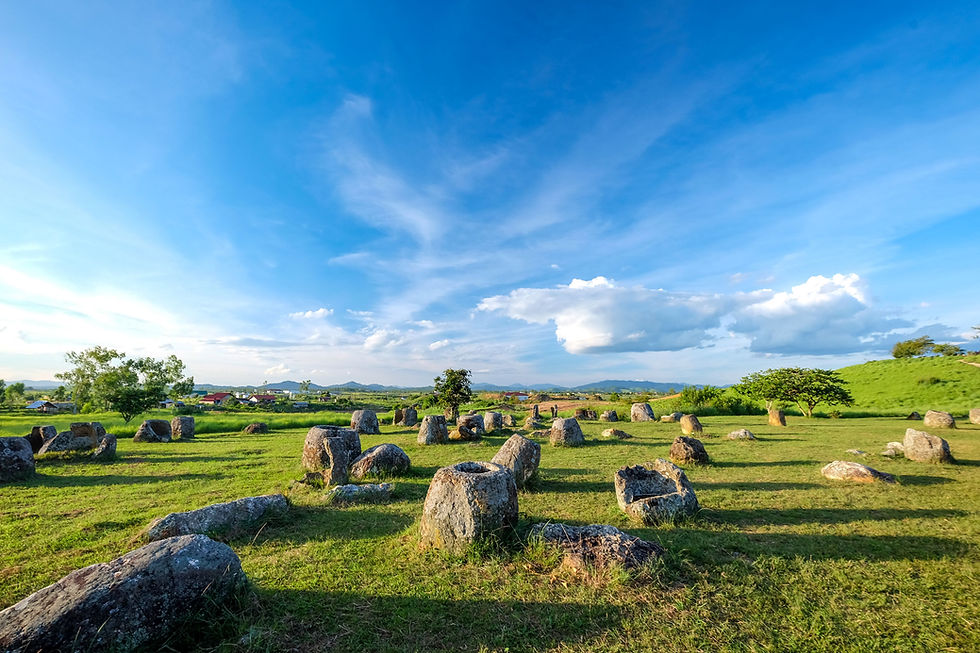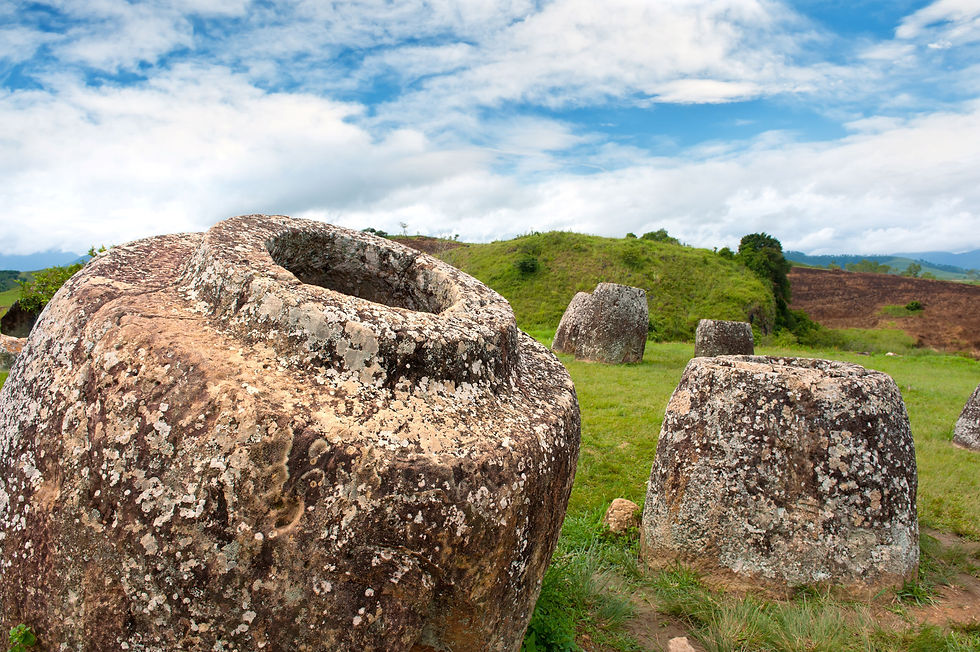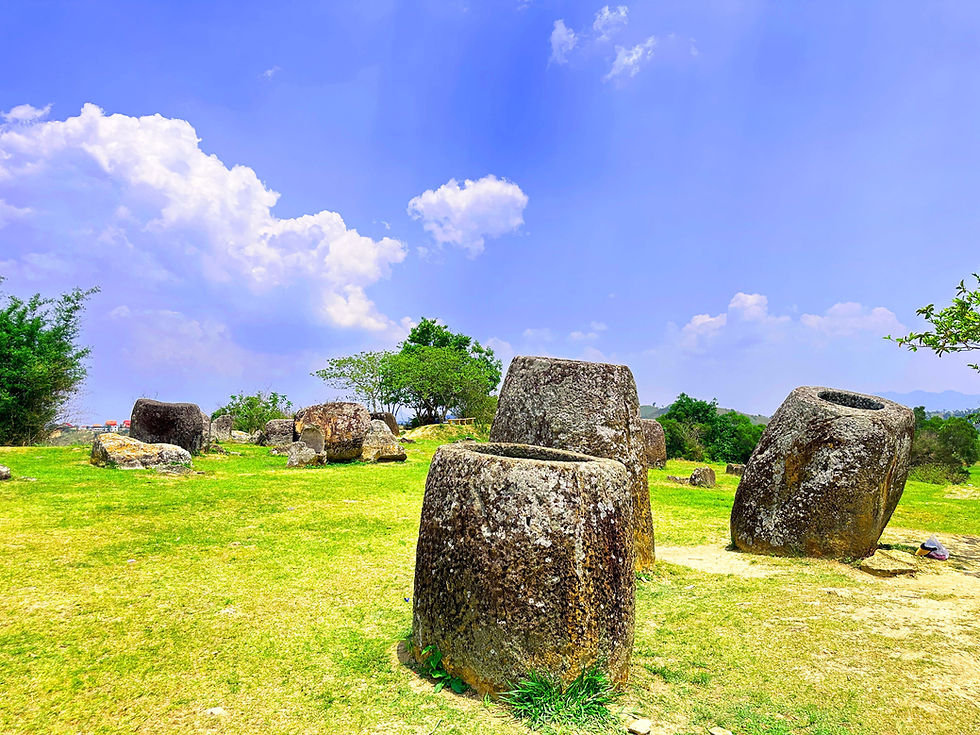Unlocking the Secrets of the Plain of Jars: Discover Laos' Mysterious Ancient Relics!
- Lodestar Travel Guide

- Jun 13, 2023
- 13 min read
Updated: Jun 12, 2024

Welcome to the mystical and captivating Plain of Jars in Laos, a place where ancient wonders await to be discovered. Nestled amidst the lush landscapes of Southeast Asia, this archaeological site is shrouded in mystery, leaving visitors intrigued by its enigmatic stone jars and the secrets they hold. We embark on a journey to unravel the hidden treasures of the Plain of Jars, delving into its historical significance, cultural heritage, and the captivating stories that lie within.
Table of Contents:
The Plain of Jars: A Glimpse into Ancient Civilizations
Unveiling the Mystery: Ancient Stone Jars and Their Significance
Exploring the Archaeological Wonders of the Plain of Jars
Cultural Heritage and Rituals: The Importance of the Plain of Jars
The Enigma Deepens: Unresolved Mysteries of the Plain of Jars
Plain of Jars Tours: Unforgettable Experiences Await
Preserving the Past: Conservation Efforts and Challenges
Local Legends and Tales: The Stories Behind the Stone Jars
The Plain of Jars in Modern Times: UNESCO World Heritage Site
Conclusion: A Journey through Time at the Plain of Jars
Top 10 Frequently Asked Questions

The Plain of Jars
The Plain of Jars is a truly mesmerizing archaeological site located in central Laos, specifically in the Xiangkhouang Province. It has captured the imagination of explorers, historians, and archaeologists for decades. The site is known for its vast collection of stone jars, which are scattered across the plains, creating a unique and awe-inspiring landscape.
The stone jars vary in size, ranging from small vessels to towering monoliths, some weighing several tons. They are made of different types of stone, including sandstone and granite, and display varying degrees of craftsmanship. These jars are believed to have been carved by ancient civilizations that inhabited the region, but their exact purpose remains shrouded in mystery.
Unveiling the Mystery: Ancient Stone Jars and Their Significance
Let's delve deeper into the mystery surrounding the ancient stone jars of the Plain of Jars and their significance.
The stone jars of the Plain of Jars have long intrigued archaeologists, historians, and curious travelers. These impressive artifacts, ranging in size from small to monumental, are scattered across the landscape, creating a captivating and enigmatic sight.
While the exact purpose of the stone jars remains uncertain, several theories have emerged to shed light on their significance. One prevailing belief is that the jars were used as funerary objects, serving as burial sites for the deceased. This theory is supported by the discovery of human remains, including bones and ashes, within some of the jars during archaeological excavations.
Another hypothesis suggests that the jars were used for secondary burials, a practice where bodies were first placed in temporary locations before being moved to their final resting places. This idea is supported by the presence of bones found around the jars but not inside them.
Some theories propose that the stone jars were used for rituals and ceremonies related to ancestral worship or fertility rites. The sheer number and distribution of the jars across multiple sites have led researchers to speculate that they may have served as communal gathering places or markers of sacred spaces.
The cultural and historical significance of the stone jars extends beyond their speculated purpose. They provide valuable insights into the ancient civilizations that once thrived in the region. The craftsmanship involved in carving these jars from stone, as well as their transportation and arrangement, showcases the advanced skills and engineering capabilities of the past societies.
In addition to their archaeological value, the stone jars hold cultural and spiritual importance for the local communities. They are considered sacred and have become part of local folklore and legends. These stories enrich the cultural heritage of the region, connecting past and present through the shared narratives associated with the jars.

Exploring the Archaeological Wonders of the Plain of Jars
As you embark on your journey through the archaeological wonders of the Plain of Jars, you will be greeted by a landscape adorned with hundreds of stone jars, each steeped in history and mystery. These jars vary in size, ranging from small and unassuming to towering monoliths that command attention.
Walking among the jar sites, you'll be captivated by the sheer scale and number of these ancient artifacts. Some jars stand tall, reaching heights of several meters, while others are smaller and more delicate in their design. Their craftsmanship is remarkable, showcasing the skill and precision of the ancient civilizations that created them.
Carved from various types of stone, including sandstone and granite, the jars exhibit different shapes and styles. Some have smooth surfaces, while others bear intricate carvings and decorations. The precise techniques used to fashion these jars thousands of years ago continue to amaze and intrigue modern-day observers.
Contemplating the purpose and methods behind the creation of the stone jars is a fascinating endeavor. How were these massive jars carved with such precision? How were they transported across the landscapes to their designated locations? These questions remain unanswered, adding to the allure and enigma of the Plain of Jars.
As you explore the jar sites, you'll be surrounded by an air of antiquity. Imagine the hands that carefully placed each jar, envision the rituals and ceremonies that may have taken place around them. The Plain of Jars invites you to ponder the ancient civilizations that once thrived in this region and to connect with the rich tapestry of their lives.
Beyond the awe-inspiring jars themselves, the surrounding landscapes add to the allure of the site. The picturesque scenery, with its rolling hills and lush vegetation, creates a tranquil ambiance that further enhances the sense of stepping back in time. It is an opportunity to immerse yourself in the history and natural beauty of Laos.
As you wander through the jar sites, take your time to absorb the atmosphere, appreciate the intricate details of the jars, and contemplate the significance they held for those who came before us. The Plain of Jars is a testament to the ingenuity, creativity, and reverence of ancient civilizations, offering a glimpse into a world that has long since passed.
Cultural Heritage and Rituals: The Importance of the Plain of Jars
The cultural heritage and rituals associated with the Plain of Jars add another layer of significance to this ancient site. For the local communities in Laos, the stone jars are not merely archaeological artifacts but hold deep cultural and spiritual value.
Throughout generations, folklore and legends have been passed down, weaving tales around the stone jars and the landscapes they inhabit. These stories serve to connect the present with the past, bridging the gap between ancient civilizations and contemporary traditions.
Local beliefs and customs regarding the stone jars vary among different ethnic groups in the region. Some consider the jars to be sacred vessels, tied to ancestral worship and spiritual practices. The jars are believed to connect the living with their ancestors, serving as a conduit between realms. Rituals and ceremonies may have been performed around the jars to honor and communicate with the spirits of the departed.
The legends associated with the Plain of Jars further enrich the cultural tapestry of Laos. These tales recount mythical beings, ancient battles, and divine creations linked to the stone jars. They provide a glimpse into the imagination and storytelling traditions of the local communities, offering insights into their worldview and the significance they attribute to the site.
The Enigma Deepens: Unresolved Mysteries of the Plain of Jars
The Plain of Jars continues to captivate and perplex researchers and visitors alike with its unresolved mysteries. Despite extensive research, excavation, and scholarly efforts, there are still significant unanswered questions surrounding this enigmatic archaeological site.
One of the most compelling mysteries is the identity of the ancient civilizations that created the stone jars. The exact origins and cultural affiliations of the people responsible for these remarkable artifacts remain uncertain. Various theories suggest that the jars might be the work of an ancient Mon-Khmer civilization, or possibly influenced by neighboring ancient societies such as the Khmer Empire or the Dong Son culture.
Another unanswered question revolves around the means by which the stone jars were transported and placed across the landscape. Some of the jars weigh several tons and are made from materials found miles away from the jar sites. How these massive jars were carved, moved, and arranged with such precision and accuracy continues to baffle researchers. The absence of clear evidence and documentation further adds to the intrigue surrounding this aspect of the Plain of Jars.
Additionally, the purpose and significance of the stone jars remain shrouded in uncertainty. While theories regarding funerary practices and rituals associated with the jars have been proposed, definitive answers have yet to be uncovered. It remains unknown how the jars were used in ancient times, what rituals or ceremonies accompanied their placement, and the exact symbolism or cultural significance they held.
The unresolved mysteries of the Plain of Jars create fertile ground for speculation, imagination, and ongoing research. They inspire a sense of wonder and curiosity, encouraging scholars and visitors to explore new avenues of investigation and hypothesis. This ongoing quest for answers fuels the fascination and allure of the site, captivating the minds of those who seek to unravel its secrets.
The Plain of Jars serves as a reminder of the vast gaps in our knowledge about ancient civilizations and their practices. It stands as a testament to the complexity and richness of human history, offering an opportunity to contemplate the mysteries that still elude us. The exploration of these mysteries keeps the site alive with a sense of wonder, inviting researchers and visitors to contribute to the ongoing narrative surrounding the Plain of Jars.

Plain of Jars Tours: Unforgettable Experiences Await
Embarking on a guided tour of the Plain of Jars is a truly immersive and enriching experience that allows you to make the most of your visit to this extraordinary archaeological site in Laos. Here's what you can expect from such a tour:
Expert Guidance: Knowledgeable guides with a deep understanding of the Plain of Jars and its significance will accompany you throughout the tour. They are well-versed in the history, archaeology, and cultural aspects of the site, ensuring that you receive accurate and insightful information.
In-depth Insights: Your guides will provide fascinating insights into the archaeological findings and ongoing research surrounding the stone jars. They will share their expertise on the theories, mysteries, and cultural significance associated with the site, enhancing your understanding and appreciation of its historical context.
Access to Multiple Sites: The Plain of Jars encompasses various jar sites scattered across the region. A guided tour will take you to the most significant and accessible sites, ensuring that you have the opportunity to explore and appreciate the diverse range of stone jars on display.
Close Encounters with the Jars: Guided tours allow you to witness the stone jars up close and personal. You'll have the chance to marvel at their size, craftsmanship, and intricate details. Your guides will provide historical context and archaeological interpretations, enabling you to better comprehend the significance of these ancient artifacts.
Cultural and Historical Context: Beyond the physical aspects of the stone jars, guided tours provide valuable insights into the cultural and historical context of the Plain of Jars. You'll learn about the beliefs, rituals, and legends associated with the site, gaining a deeper understanding of the ancient civilizations that once thrived in the region.
Interpretation and Storytelling: Guides often share local legends, stories, and anecdotes that have been passed down through generations. These narratives bring the site to life, allowing you to connect with the cultural heritage and traditions of the local communities. The interpretation and storytelling enhance the overall experience, making it more engaging and memorable.
Safety and Logistics: Guided tours ensure that you navigate the site safely and efficiently. The guides are familiar with the terrain, potential hazards, and any specific requirements for visiting the jar sites. They take care of logistical details, such as transportation and access arrangements, allowing you to focus on immersing yourself in the experience.
Enhanced Appreciation: With the guidance of experts, you'll gain a deeper appreciation for the historical, cultural, and archaeological significance of the Plain of Jars. The comprehensive and well-informed commentary provided by the guides will help you grasp the complexities and intricacies of this remarkable site.
Embarking on a guided tour of the Plain of Jars promises an unforgettable and enlightening experience. It enables you to unlock the secrets of this ancient archaeological site, immersing yourself in the rich history and cultural heritage of Laos. By exploring the jar sites under the guidance of experts, you'll gain valuable insights, make lasting memories, and develop a profound connection with the mysteries and wonders of the Plain of Jars.

Preserving the Past: Conservation Efforts and Challenges
Preserving the Plain of Jars is a critical endeavor to ensure the long-term protection and conservation of this extraordinary archaeological site. Recognizing its historical and cultural significance, concerted efforts are being made to safeguard the stone jars and mitigate potential threats to their preservation.
Conservation initiatives primarily focus on addressing several key challenges:
Weathering and Erosion: The stone jars are exposed to natural elements such as wind, rain, and sunlight, which can cause gradual weathering and erosion. Preservation efforts aim to mitigate these effects by employing protective measures such as coatings, shelters, and drainage systems to minimize water accumulation around the jars.
Human Impact: Human activities, such as physical contact, vandalism, and unauthorized excavations, pose a significant risk to the stone jars. Raising awareness among visitors and local communities about the importance of preserving the site is crucial in reducing human impact. Implementing strict regulations and monitoring systems help deter destructive actions.
Infrastructure Development: The Plain of Jars has witnessed an increase in visitor numbers, necessitating the development of infrastructure to accommodate and manage tourism. Constructing visitor facilities, including paths, viewpoints, and interpretive signs, helps regulate visitor flow and minimize environmental impact. Well-designed infrastructure ensures that access to the site is safe and sustainable.
Funding and Resources: Conservation efforts require substantial financial resources for ongoing maintenance, research, and monitoring. Securing funding from governmental bodies, international organizations, and private donors is crucial to sustain long-term preservation initiatives. Collaboration between stakeholders, including local communities, government agencies, and conservation organizations, is vital to mobilize resources effectively.
Sustainable Tourism Practices: Balancing preservation and accessibility is a delicate task. Sustainable tourism practices promote responsible visitation while minimizing negative impacts on the site's integrity. Implementing visitor guidelines, capacity limits, and educational programs helps foster a sense of stewardship among tourists and local communities, encouraging sustainable engagement with the Plain of Jars.
To ensure the effectiveness of conservation efforts, multidisciplinary approaches are adopted. These involve collaborations between archaeologists, heritage experts, environmental scientists, and local communities. Ongoing research and monitoring help assess the condition of the stone jars, identify potential threats, and refine conservation strategies.
Community involvement and engagement are vital components of preservation initiatives. Recognizing the cultural and economic significance of the site to local communities, initiatives are implemented to empower and involve them in decision-making processes. This fosters a sense of ownership and responsibility, creating sustainable conservation practices that are rooted in local knowledge and traditions.
Conserving the Plain of Jars is not only about protecting physical structures but also preserving the intangible values associated with the site. It ensures the transmission of cultural heritage, supports ongoing research, and allows future generations to connect with the historical and spiritual significance of the stone jars.
By addressing the challenges of weathering, human impact, infrastructure, funding, and sustainable tourism, preservation efforts aim to strike a delicate balance between safeguarding the site and facilitating meaningful access for visitors. Through these efforts, the Plain of Jars can continue to inspire awe, foster understanding, and serve as a testament to the rich cultural heritage of Laos for years to come.
Local Legends and Tales: The Stories Behind the Stone Jars
The local legends and tales surrounding the Plain of Jars add a captivating layer of mythology and enchantment to the already intriguing site. Passed down through generations, these stories connect the stone jars to the cultural fabric of Laos and provide a unique insight into the beliefs and traditions of the local communities.
One prevalent legend linked to the Plain of Jars tells of a giant named Khun Cheung who fought a mighty battle against his enemies. According to the tale, Khun Cheung threw enormous stone jars across the plains to defend his people, creating the scattered jar sites that exist today. These jars are said to be remnants of that ancient battle, forever frozen in time as a testament to Khun Cheung's strength and valor.
Another local legend tells of a divine creation story associated with the stone jars. According to this tale, the jars were made by powerful gods who descended to Earth and molded them out of clay to store the rainwater and ensure fertility for the land. The jars were believed to possess mystical powers and were revered as sacred vessels that brought prosperity and abundance to the region.
In addition to these myths, the stone jars are often associated with spirits and supernatural beings in local folklore. Some tales recount encounters with spirits believed to inhabit the jar sites, protecting the jars and the surrounding landscapes. These spiritual beings are said to guard the ancient secrets and watch over those who visit the site, bestowing blessings upon those who show respect and reverence.
These legends and tales not only add a sense of wonder and enchantment to the Plain of Jars but also reflect the deep spiritual connection that the local communities have with the site. They serve as a testament to the enduring cultural significance and belief systems surrounding the stone jars, weaving a narrative that connects the past with the present.
The stories passed down through generations also provide an insight into the vibrant oral traditions and storytelling heritage of Laos. They contribute to the cultural identity of the region, fostering a sense of pride and connection to the land and its ancient wonders.
The Plain of Jars in Modern Times: UNESCO World Heritage Site
Recognizing its exceptional universal value, the Plain of Jars was designated as a UNESCO World Heritage Site in 2019. This prestigious status brings global attention to the site's historical significance, promotes conservation efforts, and fosters sustainable tourism practices. The Plain of Jars now stands as a testament to Laos' rich cultural heritage and serves as a symbol of national pride.

A Journey through Time at the Plain of Jars
As we conclude our exploration of the Plain of Jars, we leave with a sense of wonder and admiration for the ancient wonders that dot the landscapes of Laos. The stone jars remain a testament to the ingenuity and craftsmanship of past civilizations, while their mysteries continue to ignite our curiosity. Visiting the Plain of Jars is not only an opportunity to uncover the secrets of the past but also to appreciate the cultural heritage and significance that this remarkable site holds.
Whether you're an archaeology enthusiast, a history buff, or an adventurous traveler seeking unique experiences, the Plain of Jars will undoubtedly leave an indelible impression. It invites you to embark on a journey through time, unraveling the mysteries of ancient Laos and connecting with the rich tapestry of its past. Plan your visit to this extraordinary site and let the stone jars whisper their tales of bygone eras as you step into the realm of Laos' ancient wonders.
Top 10 Frequently Asked Questions about the Plain of Jars:
Where is the Plain of Jars located?
The Plain of Jars is located in central Laos, specifically in the Xiangkhouang Province.
What is the significance of the stone jars?
The stone jars hold archaeological and cultural significance, with theories suggesting they were used for burial practices, food storage, or symbolic purposes.
Are the stone jars accessible to visitors?
Yes, visitors can explore the Plain of Jars and witness the stone jars up close. Guided tours are available to provide insights into the site.
Can the stone jars be touched or entered?
In order to preserve the site and protect the stone jars, visitors are generally not allowed to touch or enter the jars themselves.
How old are the stone jars?
The stone jars date back thousands of years, with their exact age still being a subject of ongoing research and archaeological study.
What is the best time to visit the Plain of Jars?
The best time to visit is during the dry season, from November to February, when the weather is pleasant, and the landscapes are lush and green.
Are there any accommodation options near the Plain of Jars?
Yes, there are accommodations available in the nearby town of Phonsavan, ranging from guesthouses to hotels, catering to different budgets.
Are there any safety concerns when visiting the Plain of Jars?
While the Plain of Jars itself is safe to visit, it's important to follow safety guidelines and heed any warnings or instructions provided by tour guides or local authorities.
Are there any ongoing preservation efforts for the Plain of Jars?
Yes, conservation efforts are being carried out to protect and preserve the stone jars, ensuring their longevity for future generations.
Can I visit the Plain of Jars independently, or do I need a guide?
While it is possible to visit independently, having a knowledgeable guide can greatly enhance your experience, providing historical context and deeper insights into the site.





